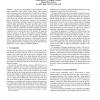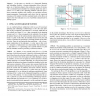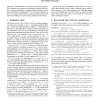ECAI
2004
Springer
14 years 9 months ago
2004
Springer
Learning general truths from the observation of simple domains and, further, learning how to use this knowledge are essential capabilities for any intelligent agent to understand ...
ECAI
2004
Springer
14 years 9 months ago
2004
Springer
Abstract. Adaptive consistency is a solving algorithm for constraint networks. Its basic step is variable elimination: it takes a network as input, and producesan equivalent networ...
ECAI
2004
Springer
14 years 9 months ago
2004
Springer
ECAI
2004
Springer
14 years 9 months ago
2004
Springer
Abstract. One key issue facing robotic teams is effective coordination mechanisms. Many robotic groups operate within domains where restrictions such as limiting areas of operation...
ECAI
2004
Springer
14 years 9 months ago
2004
Springer
We present a new conceptual abstraction in symmetry breaking – the GE-tree. The construction and traversal of a GE-tree breaks all symmetries in any constraint satisfaction or si...
ECAI
2004
Springer
14 years 9 months ago
2004
Springer
In this paper we describe IPSS (Integrated Planning and Scheduling System), a domain independent solver that integrates an AI heuristic planner, that synthesizes courses of actions...
ECAI
2004
Springer
14 years 9 months ago
2004
Springer
Abstract. The emergence of complex network structures of relationships between autonomous agents occurs in a wide range of distributed systems. Many researchers have proposed model...
ECAI
2004
Springer
14 years 9 months ago
2004
Springer
The standard SVM formulation for binary classification is based on the Hinge loss function, where errors are considered not correlated. Due to this, local information in the featu...
ECAI
2004
Springer
14 years 9 months ago
2004
Springer
Abstract. In this paper we explore the potential of adaptive recommendation techniques in an environment where users can access a variety of services from different locations, and ...
ECAI
2004
Springer
14 years 9 months ago
2004
Springer
Abstract. Defeasible logic (DL) promotes enthymemic, argumentative reasoning on incomplete set of premisses retracted on the presence of contrary information. Defeasible Prolog (d-...




